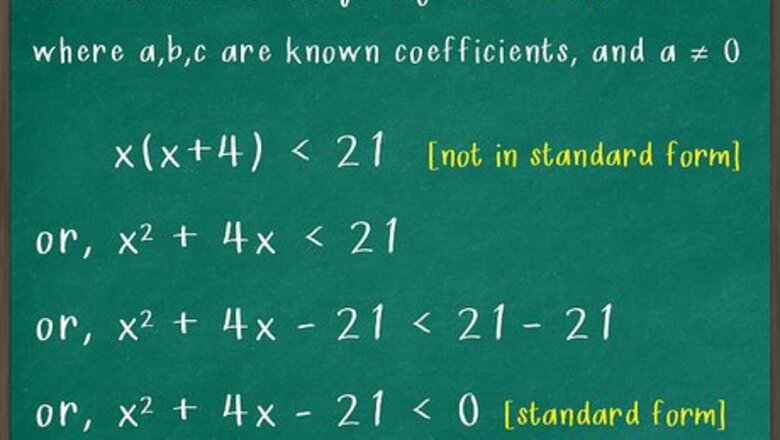
views
x
2
{\displaystyle x^{2}}
term and thus has two roots, or two x-intercepts. This results in a parabola when plotting the inequality on a coordinate plane. Solving an inequality means finding the values of x that make the inequality true. You can show these solutions algebraically, or by illustrating the inequality on a number line or coordinate plane.
Factoring the Inequality
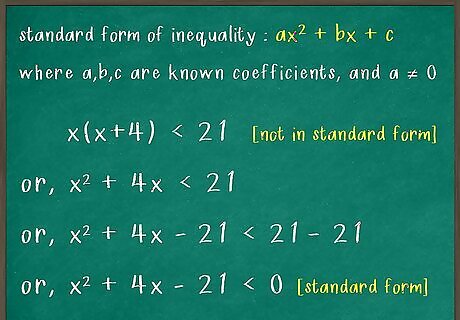
Write the inequality in the standard form. The standard form of a quadratic is a trinomial that follows the structure a x 2 + b x + c < 0 {\displaystyle ax^{2}+bx+c<0} ax^{{2}}+bx+c, where a {\displaystyle a} a, b {\displaystyle b} b, and c {\displaystyle c} c are known coefficients, and a ≠ 0 {\displaystyle a\neq 0} a\neq 0. For example, the inequality x ( x + 4 ) < 21 {\displaystyle x(x+4)<21} x(x+4) is not in standard form. First, you need to use the distributive property to multiply x {\displaystyle x} x and x + 4 {\displaystyle x+4} x+4. Then, you need to subtract 21 from both sides of the inequality: x ( x + 4 ) < 21 {\displaystyle x(x+4)<21} x(x+4) x 2 + 4 x < 21 {\displaystyle x^{2}+4x<21} x^{{2}}+4x x 2 + 4 x − 21 < 21 − 21 {\displaystyle x^{2}+4x-21<21-21} x^{{2}}+4x-21 x 2 + 4 x − 21 < 0 {\displaystyle x^{2}+4x-21<0} x^{{2}}+4x-21
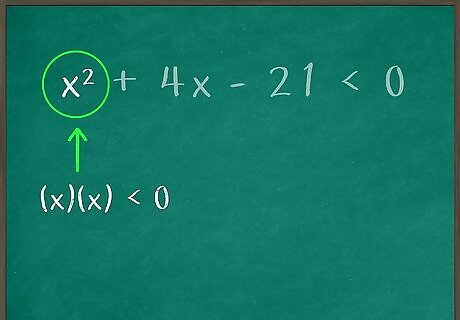
Find two factors whose product is the first term of the inequality. To factor the inequality, you need to find two binomials whose product equals the standard form of the inequality. A binomial is a two-termed expression. To do this, you need to complete the FOIL method in reverse. Begin by finding two factors for the first term of each binomial. For example, x × x = x 2 {\displaystyle x\times x=x^{2}} x\times x=x^{{2}}, so you can begin setting up your factors like this: ( x ) ( x ) < 0 {\displaystyle (x)(x)<0} (x)(x).
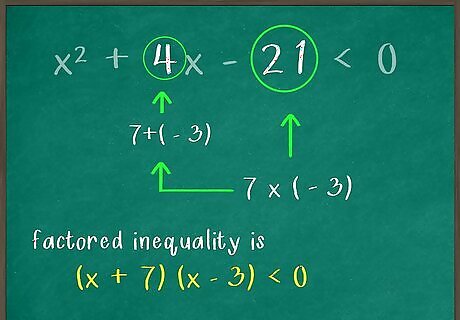
Find two factors whose product is the third term in the standard form of the inequality. These two factors must also have a sum equal to the second term in the inequality. You will likely need to do some guess-and-check work at this time, to see which two factors meet these two requirements. Make sure you pay close attention to the positive and negative signs as well. For example: 7 × − 3 = − 21 {\displaystyle 7\times -3=-21} 7\times -3=-21 -21 is the third term in the inequality, so these two factors (7 and -3) might work. Now you need to see whether the sum of these factors equals the second term ( 4 {\displaystyle 4} 4) of the inequality. Since 7 + − 3 = 4 {\displaystyle 7+-3=4} 7+-3=4, these two factors meet both requirements. So, your factored inequality is ( x + 7 ) ( x − 3 ) < 0 {\displaystyle (x+7)(x-3)<0} (x+7)(x-3).
Determining the Roots of the Inequality
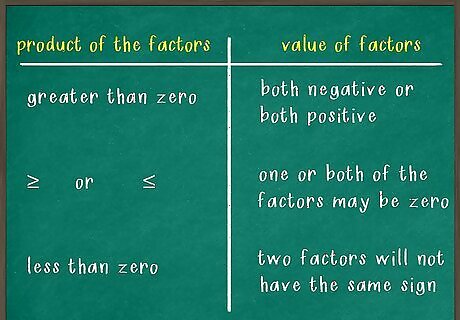
Determine whether your factors have the same sign. If, according to the inequality, the product of the factors is greater than zero, then either both factors will be negative (less than 0), or both factors will be positive (greater than 0), since a negative times a negative equals a positive, and a positive times a positive equals a positive. If the inequality is greater than or equal to ( ≥ {\displaystyle \geq } \geq ) or less than or equal to ( ≤ {\displaystyle \leq } \leq ), one or both of the factors may be zero. For example, for the inequality ( x + 7 ) ( x − 3 ) < 0 {\displaystyle (x+7)(x-3)<0} (x+7)(x-3), the product of the factors is less than 0, and so the two factors will not have the same sign.
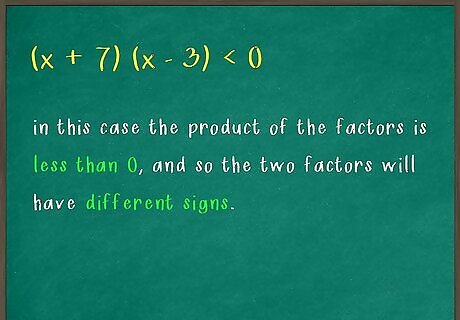
Determine whether your factors have opposite signs. If, according to the inequality, the product of the factors is less than 0, then one factor will be less than 0, or negative, and the other factor will be greater than zero, or positive. This is because a negative times a positive equals a negative. Again, if the inequality is greater than or equal to ( ≥ {\displaystyle \geq } \geq ) or less than or equal to ( ≤ {\displaystyle \leq } \leq ), one or both of the factors may be zero. For example, for the inequality ( x + 7 ) ( x − 3 ) < 0 {\displaystyle (x+7)(x-3)<0} (x+7)(x-3), the product of the factors is less than 0, and so the two factors will have different signs.
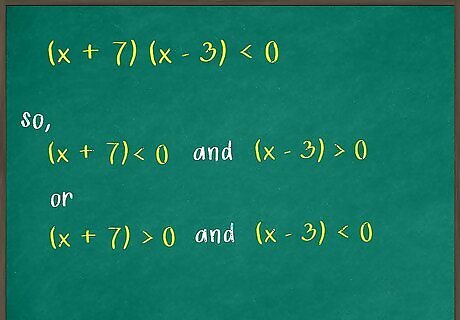
Write out the options for the roots. Write these options by turning each factor into an inequality, based on whether they will have the same or opposite signs. You should have two options. For example, you found that the factors of the inequality ( x + 7 ) ( x − 3 ) < 0 {\displaystyle (x+7)(x-3)<0} (x+7)(x-3) must have opposite signs, so your options would be stated thusly: x + 7 < 0 {\displaystyle x+7<0} x+7 AND x − 3 > 0 {\displaystyle x-3>0} x-3>0 (That is, the first factor will be negative, and the second factor will be positive.)OR x + 7 > 0 {\displaystyle x+7>0} x+7>0 AND x − 3 < 0 {\displaystyle x-3<0} x-3 (That is, the first factor will be positive, and the second factor will be negative.)
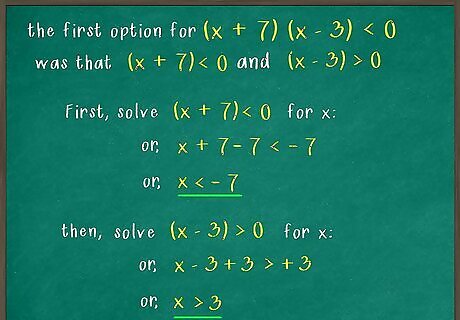
Simplify the roots for the first option. To simplify, isolate the x {\displaystyle x} x variable for each factor. Don’t forget that if you multiply or divide an inequality by a negative number, you must flip the inequality sign. For example, the first option for ( x + 7 ) ( x − 3 ) < 0 {\displaystyle (x+7)(x-3)<0} (x+7)(x-3) was that x + 7 < 0 {\displaystyle x+7<0} x+7 AND x − 3 > 0 {\displaystyle x-3>0} x-3>0. First, solve x + 7 < 0 {\displaystyle x+7<0} x+7 for x {\displaystyle x} x: x + 7 − 7 < 0 − 7 {\displaystyle x+7-7<0-7} x+7-7 x < − 7 {\displaystyle x<-7} x Then solve x − 3 > 0 {\displaystyle x-3>0} x-3>0 for x {\displaystyle x} x: x − 3 + 3 > 0 + 3 {\displaystyle x-3+3>0+3} x-3+3>0+3 x < 3 {\displaystyle x<3} x So, your simplified roots for the first option are x < − 7 {\displaystyle x<-7} x and x > 3 {\displaystyle x>3} x>3.
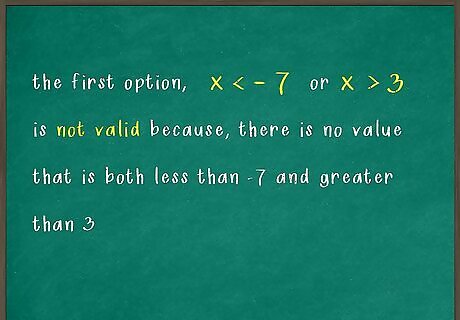
Check the validity of the roots for your first option. To do this, see whether you can combine the roots to make a correct inequality. If you can find values that are true for both roots, then the option is valid. If you can’t, the roots in this option are not valid. For example, for the first option, x < − 7 {\displaystyle x<-7} x and x > 3 {\displaystyle x>3} x>3, you need to determine whether there are values that satisfy both requirements. Ask yourself, is there a value that is both less than -7 and greater than 3? Since no number can be both less than -7 and greater than 3, you know that this option is not valid.
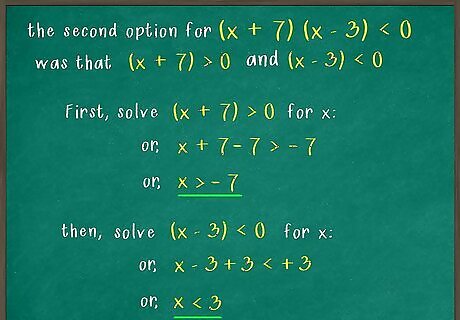
Simplify the roots of the second option. Isolate the x {\displaystyle x} x variable for each factor, remembering to flip the inequality sign if you multiply or divide by a negative number. For example, the second option for ( x + 7 ) ( x − 3 ) < 0 {\displaystyle (x+7)(x-3)<0} (x+7)(x-3) was that x + 7 > 0 {\displaystyle x+7>0} x+7>0 AND x − 3 < 0 {\displaystyle x-3<0} x-3. First, solve x + 7 > 0 {\displaystyle x+7>0} x+7>0 for x {\displaystyle x} x: x + 7 − 7 > 0 − 7 {\displaystyle x+7-7>0-7} x+7-7>0-7 x > − 7 {\displaystyle x>-7} x>-7 Then solve x − 3 < 0 {\displaystyle x-3<0} x-3 for x {\displaystyle x} x: x − 3 + 3 < 0 + 3 {\displaystyle x-3+3<0+3} x-3+3 x < 3 {\displaystyle x<3} x So, your simplified roots for the second option are x > − 7 {\displaystyle x>-7} x>-7 and x < 3 {\displaystyle x<3} x.
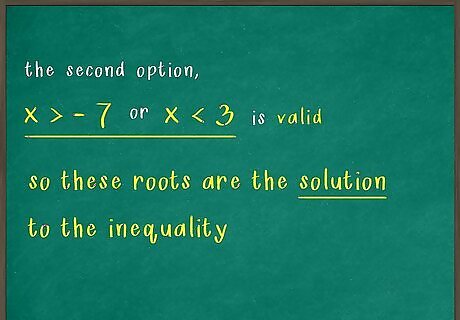
Check the validity of the roots for your second option. If you can find values that are true for both roots, then the option is valid. If you can’t, the roots in this option are not valid. For example, the second option is that x > − 7 {\displaystyle x>-7} x>-7 and x < 3 {\displaystyle x<3} x, so you need to find a value for x {\displaystyle x} x that would satisfy both inequalities. Ask yourself, is there a value that is both greater than -7 and less than 3? Since there are many numbers that are both greater than -7 and less than 3 (0, for example), you know that this option is valid, and so these roots are the solution to the inequality.
Plotting the Solution Set on a Number Line

Draw a number line. Make sure you draw it according to any required specifications. If your number line has no specifications, just make sure to include positions for both x {\displaystyle x} x values your found previously. Include a few values above and below these to make the number line easier to interpret. For example, since the roots for the inequality x ( x + 4 ) < 21 {\displaystyle x(x+4)<21} x(x+4) are x > − 7 {\displaystyle x>-7} x>-7 and x < 3 {\displaystyle x<3} x, draw a number line that includes positions for -7 and 3.
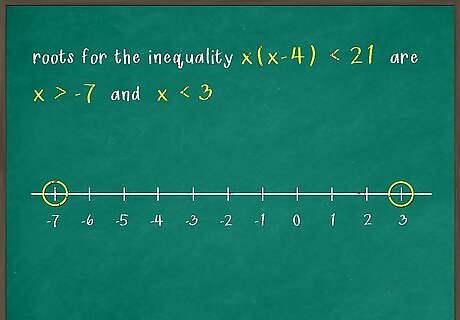
Plot the x {\displaystyle x} x values on the number line. Plot the points by drawing a circle over their position on the number line. If the inequality is greater than ( > {\displaystyle >} >) or less than ( < {\displaystyle <} ), draw an open circle. If the inequality is greater than or equal to ( ≥ {\displaystyle \geq } \geq ) or less than or equal to ( ≤ {\displaystyle \leq } \leq ), fill in the circle on the number line, since the values are included in the set. For example, since the roots your are working with are x > − 7 {\displaystyle x>-7} x>-7 and x < 3 {\displaystyle x<3} x, you would draw open circles at the -7 and 3 positions on the number line.
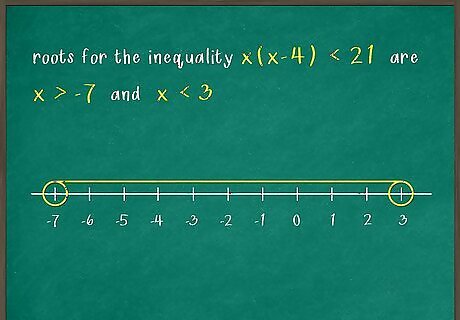
Draw arrows or lines indicating the included values. If x {\displaystyle x} x is greater than the value, draw a line pointing to the right on the number line, since the included values will be larger than x {\displaystyle x} x. If x {\displaystyle x} x is less than the value, draw a line pointing to the left on the number line, since the included values will be less than x {\displaystyle x} x. If the included values are between two numbers, you will draw a line between the two plotted points. For example, since you want to show that x > − 7 {\displaystyle x>-7} x>-7 but also x < 3 {\displaystyle x<3} x, you need to draw a line between -7 and 3 on the number line.
Plotting the Solution Set on a Coordinate Plane
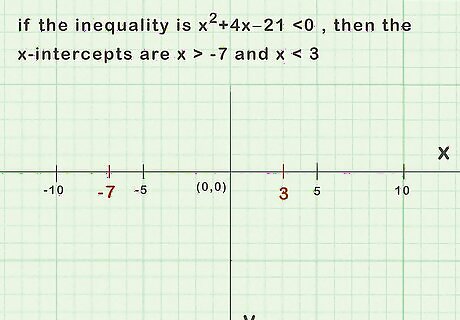
Plot the x-intercepts on the coordinate plane. An x-intercept is a point where the parabola crosses the x-axis. The two roots you found are the x-intercepts. For example, if the inequality is x 2 + 4 x − 21 < 0 {\displaystyle x^{2}+4x-21<0} x^{{2}}+4x-21, then the x-intercepts are x > − 7 {\displaystyle x>-7} x>-7 and x < 3 {\displaystyle x<3} x, since these are the roots you found when using the quadratic formula or factoring.
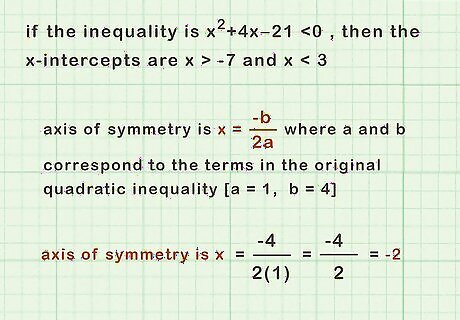
Find the axis of symmetry. The axis of symmetry is the line that cuts the parabola in half. To find the axis of symmetry, use the formula x = − b 2 a {\displaystyle x={\frac {-b}{2a}}} x={\frac {-b}{2a}}, where a {\displaystyle a} a and b {\displaystyle b} b correspond to the terms in the original quadratic inequality. For example, for the inequality x 2 + 4 x − 21 < 0 {\displaystyle x^{2}+4x-21<0} x^{{2}}+4x-21, you will first calculate x = − 4 2 ( 1 ) {\displaystyle x={\frac {-4}{2(1)}}} x={\frac {-4}{2(1)}}: x = − 4 2 {\displaystyle x={\frac {-4}{2}}} x={\frac {-4}{2}} x = − 2 {\displaystyle x=-2} x=-2. So, the axis of symmetry is the line x = − 2 {\displaystyle x=-2} x=-2
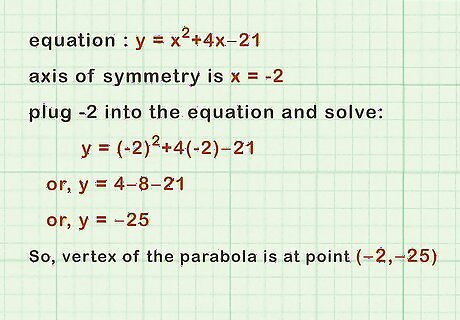
Find the vertex of the parabola. The vertex is the high or low point of the parabola. To find the vertex, first change the original inequality into an equation equal to y {\displaystyle y} y. Then plug the x {\displaystyle x} x value you found for the axis of symmetry into the equation. For example, if the axis of symmetry is x = − 2 {\displaystyle x=-2} x=-2, plug -2 into the equation and solve: y = ( − 2 ) 2 + 4 ( − 2 ) + − 21 {\displaystyle y=(-2)^{2}+4(-2)+-21} y=(-2)^{{2}}+4(-2)+-21 y = 4 − 8 − 21 {\displaystyle y=4-8-21} y=4-8-21 y = 4 − 8 − 21 {\displaystyle y=4-8-21} y=4-8-21So, the vertex of the parabola is at the point ( − 2 , − 25 ) {\displaystyle (-2,-25)} (-2,-25).
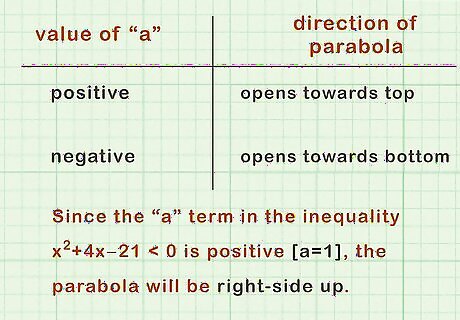
Determine the direction of the parabola. To know the direction of the parabola, look at the a {\displaystyle a} a term of the inequality in standard form. If the a {\displaystyle a} a term is positive, the parabola will “right-side up,” meaning it opens towards the top. If the a {\displaystyle a} a term is negative, the parabola will be “upside down,” meaning it opens towards the bottom. Since the a {\displaystyle a} a term in the inequality x 2 + 4 x − 21 < 0 {\displaystyle x^{2}+4x-21<0} x^{{2}}+4x-21 is positive, the parabola will be right-side up.
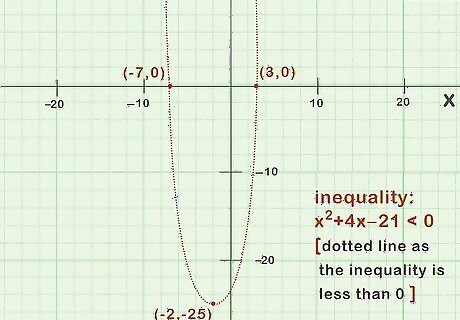
Draw the parabola with a solid or dotted line. If the inequality is greater than or equal to ( ≥ {\displaystyle \geq } \geq ) or less than or equal to ( ≤ {\displaystyle \leq } \leq ), draw the parabola with a solid line, since the values on the line are included in the solution set. If the inequality is greater than ( > {\displaystyle >} >) or less than ( < {\displaystyle <} ), draw the parabola with a dotted line, since the values on the line are not included in the solution set. Since the line x 2 + 4 x − 21 < 0 {\displaystyle x^{2}+4x-21<0} x^{{2}}+4x-21 is less than zero (not less or equal to), you should draw the parabola with a dotted line.
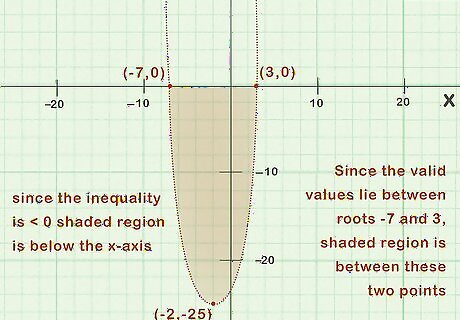
Shade the graph. To know whether to shade above or below the x-axis, you need to look at the original inequality. If the inequality is less than zero, you will shade below the x-axis. If the inequality is greater than zero, you will shade above the x-axis. To know whether to shade inside the parabola or outside of the parabola, look at your roots, or your number line. If the valid values of x {\displaystyle x} x lie between the two roots, you will shade inside the parabola. If the valid values of x {\displaystyle x} x lie outside the two roots, you will shade outside the parabola. For example, since the inequality is x 2 + 4 x − 21 < 0 {\displaystyle x^{2}+4x-21<0} x^{{2}}+4x-21, you will shade a region below the x-axis. Since the valid values lie between the roots -7 and 3, you will shade the region between these two points.




















Comments
0 comment